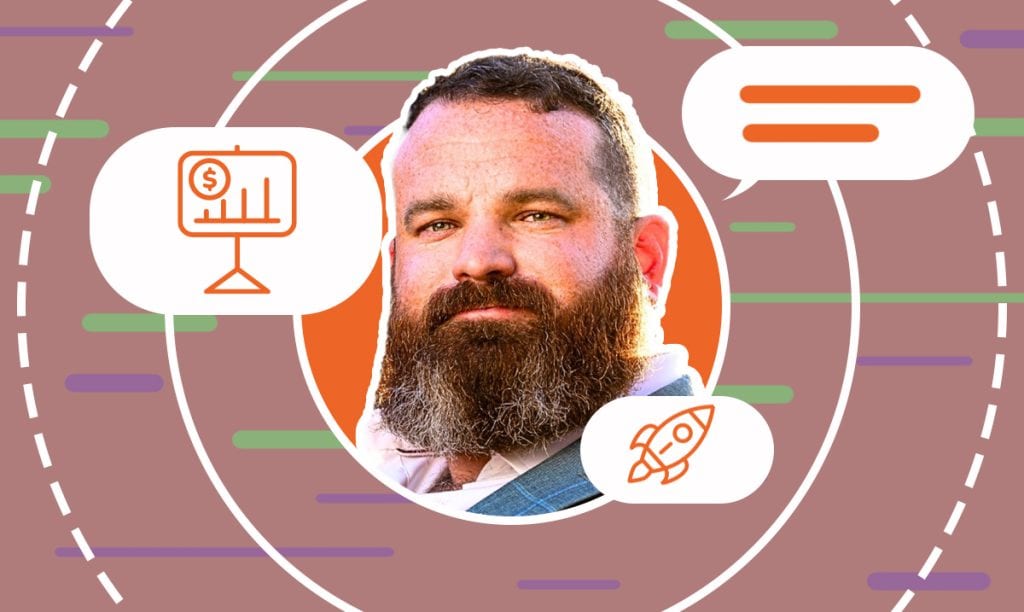Meet Vadim Bozhko, the visionary behind Bozh Studio — a branding and web design business dedicated to helping service-based companies stand out.Fu ...
Phillip Stemann Talks SEO Strategies and Trends
Written by: Howard Tillerman
Howard Tillerman is the Chief Marketing Officer for Step By Step Business and an award-winning marketing professional.
Published on March 8, 2024

Meet Phillip Stemann, the force behind the renowned SEO consultancy service phillipstemann.com. With a rich background melding technical prowess and a personalized approach, Phillip has carved out a niche in the competitive world of SEO. His expertise spans across critical areas such as content strategy, technical SEO, and a range of bespoke digital marketing solutions.
Today, we dive into his insights and experiences to uncover the secrets of succeeding in the ever-evolving world of SEO and digital marketing. Join us as we explore the journey and strategies of one of the industry’s most insightful experts.
From Programming to SEO
SBS – How did your background in programming influence your SEO approach?
Phillip – I’ve always been a super curious mind. I’ve been programming since I was 13 years old. I just took a PHP file and messed around with it to see what it did, and I was so amazed that some text could become something visual.
It developed from there, and I built 100 different projects, both my own and for clients when I became older. That was also the first step into entrepreneurship.
Today, all I do is SEO. I transitioned from programming to SEO because SEO also has a technical part. I started with the technical part of optimizing websites for the schemas, the speed, and all these things that happen behind the scenes that people don’t see. I was fascinated just to be able to cut 0.1% of a page. Those small victories were incredible.
Then, I opened my mind to a whole other world of SEO with the on-page, the content itself, building links, internal links, and everything else.
Key Elements of a Successful Content Strategy
SBS – What are the key elements of a successful content strategy in today’s SEO?
Phillip – SEO has changed a lot. Some years back, all you had to do was find keywords with low competition, write some content, and boom — you’re ranking number one. You could build some backlinks if you wanted, but you ranked number one even if you didn’t. It was super easy, but it has changed.
Today, a successful content strategy for me, based on my opinion and experience, is to create a topical map. You lay out the entire area of what content you need to cover to become a topical authority within your industry, and then you write much more strategically. Instead of writing a piece of content in one cluster and a piece of content in another, you exhaust one content cluster before you move on to another one. It also makes your life so much easier because when you have to interlink all of your content pieces that are closely related, it’s just much easier to interlink your content.
From there, it’s important to understand that content is there to drive traffic (I agree), but you also need to convert that traffic. That’s the part that many SEOs forget. They just drive the traffic, and then the job’s done. But it’s so important to convert that traffic because otherwise, it’s just worth nothing unless you have ads and people stay long on your site.
Converting Traffic
SBS – What are your strategies to convert traffic?
Phillip – I always like to talk about primary and secondary conversions. Primary conversions can vary depending on what type of website you have. For example, if you have an ecommerce website, a primary conversion could be that they bought something. The secondary conversion is often that they sign up for your newsletter. I always say it’s so good to have the hard and then the soft conversions that you can later turn into the hard conversions.
It’s really all about testing because one thing might work for one piece of content and not for another. For example, you may add a simple in-page banner where people can sign up for your newsletter, which may work for that content.
Creating super-specific lead magnets for content works well. If you’re writing a piece of content, instead of just giving readers a lead magnet that is generic to your industry, give them one that’s super specific to the piece of content they’re reading right now. This also helps increase the conversion rate.
Today, it’s fairly easy to make all these lead magnets as long as you have the knowledge, of course.
Balancing Technical SEO and Creative Content Creation
SBS – How do you combine the technical side of SEO and being creative in content creation?
Phillip – It’s not easy, to be honest, but I would say the technical part is often a one-off thing and then you just need to maintain it.
Often, if I take on a new client, I first do a technical audit of the website, where I figure out everything we need to fix. Often, many bloated plugins or unnecessary things are making the website slow. I get rid of those things and ensure that all the content is being indexed (and I check that in Google Search Console). I ensure the technical setup is in order so you have a strong foundation to build content. When that is in order, I just maintain it once a month or once a week, depending on the client.
For the content part, it often comes through the topical map. Let’s say I have a topical map (and if I don’t have it already, then I’ll make one), and then we can pick out a piece of content. Often, it’s not me writing the content for those websites, though I do write content for my website.
I do it the same way I suggest to my clients: When you take a piece of content and want to write for that keyword, you need to do some research first. I like to check what’s already ranking, what they’re doing well, and what sections they cover because if they are doing well right now, then Google likes what they’re doing. Of course, there are a lot of other factors, but the content is very important, so I check the first three to five results depending on the type of content that’s ranking. I write that down and build an outline based on that. It depends on what the client wants. For example, they may first want an AI draft, and then we edit it based on that, or we write it ourselves.
I never just published pure AI content. I can’t recommend that, especially with the March Google update coming. I think it’s going to hit those who just generate and publish. You have to remember that AI is just summarizing the content that’s already out there. It’s not adding anything new to Google. Google doesn’t experience information gained from AI content; it just sees the same things written in a different way.
Common SEO Mistakes
SBS – What are the most common SEO mistakes businesses often make daily?
Phillip – There are some obvious mistakes, like when they’re not hitting search intent. They’re writing a piece of content that people are not looking for, and they’re writing it in a format that’s just not right.
One of the things that I’ve seen recently is that people don’t give the answer straight away in the content. If I search a query on Google and I go to a piece of content, if I don’t get the answer right away, then I will leave. People think they need to put the answer at the bottom because then people read the entire content. However, it just doesn’t work that way anymore. People want the answer, and if they’re more curious, they will continue reading your content if it’s great.
Another mistake I’ve seen is that it’s difficult to read the content either because it’s so clamped together without breaking up paragraphs or there are so many ads that it’s just impossible to read.
That’s what I see the most, and fixing those elements is crucial.
Evaluating the Effectiveness of SEO Tools
SBS – What criteria do you use to see if an SEO tool is effective?
Phillip – It’s a combination of many factors. I have tried many SEO tools, and I share all of my reviews on my YouTube channel.
I always look for four elements: the size of the database, the competitor research module, rank tracking, and the content optimization module.
The size of the database is important because there are so many tools out there that just use an API called DataForSEO, which is fine. However, I like it when SEO tools take it a step further and add their content, data, and crawl data because that makes them unique.
I need some type of competitor research module where I can compare my site to the competitors to see what they’re doing that I’m not doing and vice versa.
I may or may not need rank tracking, but I like it when SEO tools have it so I can track my money keywords, the most important keywords.
I also like SEO tools that have a content optimization module, but that’s not a must.
So, a perfect SEO tool has everything in one place so I can write my content, ensure that I use all the correct terms, cover the right natural language processing terms that Google is looking for, and so on. The database is probably the most important element because the larger the database, the more keywords are easier to find and write content for.
Tailoring SEO Strategies for Local and Global Businesses
SBS – How do you tailor your SEO strategies for local and global businesses?
Phillip – For local SEO, I base a lot on two things.
The Google Business profile is incredibly important. It’s important to write an optimized description with all the information about your business and acquire good reviews on it.
When it comes to the content, I like to go city by city. With local SEO, you often cover a couple of cities to which you offer your service. I like to focus on one
city first and then move over to the other. That can be anything from optimizing for the “best craftsman in X city” to optimizing for “X near me.” I treat a city as a content cluster and just go city by city.
With global SEO, I just take the seed keyword and build out an entire global topical map for everything within that industry. Then, I choose one topic class and go from there.
Of course, there are many more strategies. With local SEO, there are also local citations, and you want to be part of Tripadvisor and all these libraries that can link to your website.
Once you have these down, you can start figuring out how to get backlinks to your websites, optimize your content, build internal links, etc.
Adaptive Link Building Approaches
SBS – What is your approach to link building since it is constantly changing?
Phillip – For external link building, I use two tactics.
One way is that I get cited. I’ve signed up for Help a Reporter Out, Featured.com, Help a B2B Writer, and similar platforms, so every day, I get a couple of emails with a list of queries. I check whether my knowledge suits any of those, and if they use my answer, I’ll get cited.
I can’t be an expert in everything, and I’m definitely not an expert in reaching out and getting backlinks, so I partner up with and use other PR agencies that help me run PR campaigns. That’s another tactic for building external links.
SBS – How often do you think internal links should be updated?
Phillip – I update my internal links whenever I create a new blog post or optimize an old one. When I create a new blog post, I find 5–10 related blog posts that I can link to the new blog post to send traffic to it. When I optimize older pieces of content, I also see if some of the newer pieces of content I’ve written can link to these older pieces of content.
Case Study: Interesting and Challenging SEO Project
SBS – Can you describe one SEO project that was interesting and challenging but you managed to do it effectively?
Phillip – I had a client whose content had been decreasing for a while, and they were really hit with the ACU last year, and they lost a lot of traffic.
The most obvious thing was to go through all of their content. They had a lot of outdated content, and it was clear to me that all of this outdated content was no longer helpful in the way that Google finds content helpful. So, we deleted many of these content pieces because they were no longer relevant.
We also optimized every old piece of content we could find. It was such a tedious, long process, and even though we didn’t see the immediate tick-up, we could see that the traffic was slowly coming back, and the client started ranking again. Sometimes, when people recover after a major core update, they get that hockey stick-like growth graph. We didn’t see that here; we just saw the slow increase, which is super positive, of course.
The challenging part was staying consistent and updating the content every single day. It was, again, a tedious process, and sometimes you had to delete something. The owner of the site was very attached to his content, so it was sometimes hard for him to delete his pieces of content, but he just had to do it because it was pulling down all of the other content, and it was no longer relevant at all. It was basically a piece of content about a product that no longer existed — and you can’t optimize that.
Advice for Starting a Successful SEO Business
SBS – What advice would you give someone who wants to start an SEO business and be successful?
Phillip – I would start by creating my own website and content and learning by doing. Test and try everything you want, see what works, and then continue to use that. If it goes well, then you’ll build up a client case that you can use to showcase to your future clients. You can also have multiple sites, but start with one and watch many YouTube channels, sign up for some podcasts, and apply everything you’ve learned to the website to see how it’s going. That’s the way that I would go about it.
Subscribe to Our Newsletter
and gain insider access to cutting-edge business insights and trends.
Featured Resources

How “Less but Better” Drives Bozh Studio’s Design Edge
Published on April 3, 2025
Read Now

How No Code Map App Delivers Custom Maps Without Coding
Published on April 3, 2025
In this interview, we sit down with Nan Zhou, co-founder of No Code Map App, to discuss how she and her team transformed a trip-planning mapinterfac ...
Read Now

How David Pere Helps Veterans Achieve Financial Freedom
Published on April 3, 2025
In this interview, David Pere, the founder of From Military to Millionaire, shares his inspiring journey from the Marine Corps to financial freedomt ...
Read Now
Comments